Previous – 20. Bullpen? Bullshit!! | Contents | Next – 22. Allegory Of His Life
We’re honored to be able to publish Stan Taylor’s Kirby biography here in the state he sent it to us, with only the slightest bit of editing. – Rand Hoppe
BRAND NEW WORLD
By 1970, thousands of Americans were actively protesting the Vietnam War. There were numerous reasons why these protests took place. Some of the prominent ones included revelations that former President Lyndon Baines Johnson had misled the American people about the Gulf of Tonkin Incident, which led to the escalation of American involvement in Vietnam in late 1964. The ending of college deferments, which previously had exempted most college students from the draft and service in Vietnam, further contributed to the protests. On April 30, 1970 President Nixon announced that the war was spreading into Cambodia, a neighbor of Viet Nam. America erupted. Colleges across the country staged a strike and shut down campuses, streets, traffic and commerce. On May 5, a stunned nation watched in horror as a small, and fearful band of National Guardsmen opened fire on a large group of boisterous and threatening group of coeds at Kent State University. For 13 seconds they fired round after round, and when the smoke cleared, four young Americans lay dead, dozens wounded and a nation staggered. Ten days later two more Americans were killed at Jackson State.
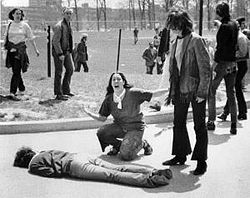
Moment of horror
On April 10, 1970, the music, and counter cultural world was staggered when Paul McCartney announced that after a yearlong period of dissension he was leaving the Beatles due to undisclosed “personal, business and musical differences.” The greatest songwriting team in history had come to an end. John was mad because he wanted to announce the split first, but had been talked out of it. His reaction to Paul’s announcement was “Shit, Paul’s a bloody f**king great PR man—maybe the best ever–to tie it into his own album’s release.” I think Jack might disagree with John as he considered Stan Lee the best PR man ever.


All good things must end – The new team
And like a rifle shot to the gut, Kirby’s defection likewise staggered the collected comic universe. Fanzines and comic conventions were ablaze with speculation as to Marvel’s continued success without Kirby. The comic creating team that dominated the Sixties had parted in discord. Kirby’s move to Los Angeles took awhile to settle out. After initially landing south in the land of Mickey Mouse, Jack soon moved north of the city to a place on Sapra Rd. The worst problem was the house was high on a hill, and below the house was an open area where motorcyclists practiced their sport. Despite numerous complaints from the hard-pressed Kirby’s, the owner refused to stop the noise. In his own way Kirby worked these motorcyclists into his tableau. The cycle riding Outsiders of the Wild Area were based on his abusive neighbors.
Jack and Roz finally moved pot, pans and drawing table to a new home in Thousand Oaks on Lynn Rd, high on the hills overlooking the valley to one side and the ocean on the other. Kirby loved the swimming pool. Despite the distance, fans and assorted kooks found their way to spend time with their king. Lisa would joke that “if Charles Manson came calling, Jack would let him in.” It was at this house that Jack, Mark, Steve, Neal, and Mike would hatch their schemes and act out their wild stories.



New Gods prototypes – New Gods #1
John Romita worried about the continuation of Marvel Comics. He thought Marvel might go under sans Kirby. “Kirby was doing more than artwork: he was bringing all sorts of things to the table. He was bringing characters, plots and inspiration to Stan. He was making Stan ten times a better writer and there’s no way to limit what you could give a guy like Jack. I would have given him whatever he wanted, but businessmen don’t see things that way.” Unknown at the time, Jack asked John Romita to join him at DC. John pondered the question, but when he asked his wife, she told him that if he went, he would always be in the shadow of Jack Kirby. John chose to remain with Stan Lee and not surprisingly was always viewed as Stan Lee’s lackey. John Buscema was more direct; “I’ll never forget when I walked into Stan’s office and heard that Jack left. I thought they were going to close up! (laughter) As far as I was concerned, Jack was the backbone of Marvel. John offered up another amazing anecdote of Kirby; “Well, Jack Kirby was very fast. Martin Goodman was upset that Jack Kirby was making so much money. He felt, “Kirby’s turning out so much work, let’s cut his rate.” That’s when Jack left Marvel and went over to DC.” Sounds like the logic of a bean counter.
The falling sales figures were scaring Martin Goodman. None of the new titles were catching on. Roy Thomas told Stan that he had received mail from readers asking for a sword and sorcery genre book. Nothing else was selling so Stan told Roy to write up a proposal for Martin Goodman to read. First, in the back of a horror title they threw in a sword and sorcery trial story. The story was written by Thomas and drawn by Barry Smith. Smith had returned to England due to his visa problem. Yet Marvel still sent him scripts to keep active. Goodman gave Thomas the ok on a new series and told him to get the rights to a property as cheaply as possible. After being disappointed with several properties, the rights to Robert Howard’s Conan practically fell into his lap. Goodman’s fear of the new title made it so that Thomas could not have his first choice of artists due to their high page rate. Thomas had wanted John Buscema, but ended up getting Barry Smith due to his being at the bottom of the page rate scale. Barry was put right to work on the new title. Coincidently, the first issue hit the stands the same month as Jack Kirby’s new titles at DC. Despite some poor initial sales, they stuck with it until it became Marvel’s sole success story of the early 1970’s. Its success did nothing to stem the loss from the other titles. Marvel continued down the hole of failure.


Jack Kirby roots to neo-romantic classicism – Barry became Windsor-Smith
Barry Smith was still living in Great Britain; working on his papers to return to the U.S. He found out about Kirby leaving Marvel from his friend Roy Thomas. It began; “There’s no way to say this but straight: Jack Kirby has left Marvel.” “Jack’s departure was cataclysmic to Stan and Marvel as a publishing entity. It affected me in no way whatsoever, I just wished him well. As to being treated fairly by the company that he co created, I’m not privy to the internal goings on that existed between Jack and Marvel management, but I would hazard a guess that if Jack was less of a romantic and more of a business man, he could have had anything he wanted from Marvel at the time that Jack felt the urge to split the “House of Ideas”. It’s a pretty good shot that Jack could have written his own ticket. But then again, if Kirby had more of a head for business, he probably wouldn’t have been the genius artist we have all benefited from. There’s a tragedy of some considerable proportion right there, Know what I mean?”
The failure in this case was not Kirby’s lack of business sense, in fact, with the facts we have Kirby made all the right moves. He used the little leverage he had and came out with the better contract. The failure was Marvels. The new management and some of the old failed to realize the real set-up and chose Stan Lee as architect rather than who many would consider the actual architect—Jack Kirby. They ended up with a new leader who could provide nothing to make a company grow, while Kirby continued his history of providing his employer with salable concepts. I have had people tell me that Marvel managed just fine after Kirby left. All I can say s that they should look at the sales charts and realize that for the next 8 years Marvel would flail about approaching bankruptcy. While the ten years earlier, while Kirby was there, the sales were a consistent rise to prominence.
Jack was busy organizing his characters and concepts for his new series. His first move was to contact Mark Evanier and Steve Sherman. After explaining that he was moving to DC where he would be in charge of a series of comics and he said he wanted them to be his assistants. They quickly agreed though they had no idea of how they could assist Kirby–but they certainly wanted to be a part of it. They also hoped their friend Mike Royer could be a part of Kirby’s new venture. Mike Royer remembers; “A few hours later I got a call from Jack saying he’d just landed at LAX and he wanted me to know that he had switched to DC, and that he wanted me to ink the books but they had to control them back East. So he couldn’t designate who he wanted to ink for him.”
Wally Wood learned of Kirby’s defection and hurriedly went to Carmine. He asked if he could be the new inker but DC stuck by their guns and stayed with Vince Colletta.
Alan Kupperberg was a production man in DC’s studio when Woody came to see Carmine. “When word first ricocheted around the business that Jack Kirby had decamped for DC Comics in 1970, Woody contacted DC publisher Carmine Infantino and virtually begged for the Kirby assignment. If I recall correctly, Wood even offered to take a cut in his page-rate. Carmine declined. I assume DC sought a continuity of the “Marvel Style”, in Colletta. Plus, garrulous Vinnie was always “there,” in the DC office. Woody was withdrawn, almost a hermit and, probably unfairly, not always considered reliable with deadlines.”
This would allow New York the final say as to what was published. . DC’s brass wanted Kirby to take over an ongoing series so that Kirby’s magic might be quickly integrated with the DC Universe. Kirby’s response was to ask for a series without a steady artist so that he wouldn’t deprive a fellow artist of work. This was resolved when the artist on Superman’s Pal Jimmy Olsen was assigned to another strip. Kirby had pleaded with Carmine to create a series of books based on his concepts, and guided by Kirby, but drawn by various artists such as Don Heck, John Romita and Steve Ditko. Carmine had hired Kirby so that Kirby’s art would be seen under the DC brand. Carmine, probably considering the additional cost of more artists quickly put the kibosh on that idea. It was decided that Kirby’s new concepts would be broken into four separate but interconnected series, drawn and written by Kirby and published bi-monthly.
Jack was ready to start up at DC Comics, but some house cleaning first had to be done, When Carmine Infantino announced to DC’s editorial staff that Jack Kirby was joining their ranks, the response was not all positive. Here’s Carmine’s recollection;
“I inform Mort Weisinger he has a new artist/writer on JIMMY OLSEN and it’s Jack Kirby. Well, the fact that I just acquired Marvel’s hottest talent didn’t impress him. All he could think about was that Kirby had sued his friend Schiff, and that Kirby should still be blacklisted from DC. Mort went to Irwin Donenfeld to complain. Donenfeld called me in and I really had to go to bat for Jack. I told Donenfeld I wasn’t interested in personality problems; I was only interested in business. Donenfeld said okay and that was the end of the discussion”.
With that distraction out of the way they now had to decide just what Kirby would do.
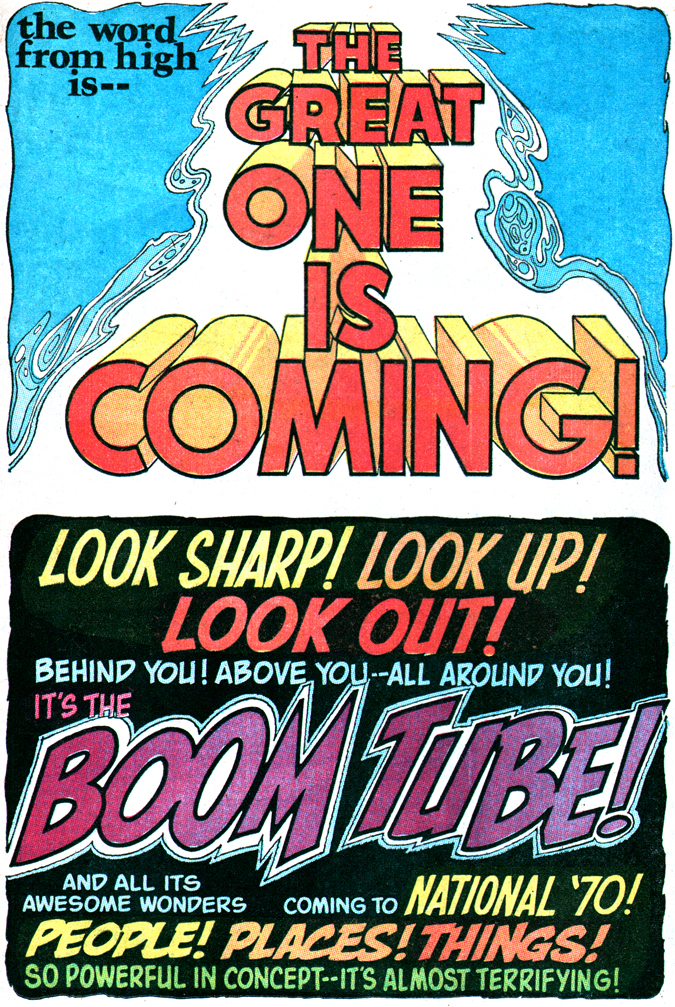
shape of things to come
DC’s publicity dept. went into overdrive. In large bold heading’s the phrase KIRBY IS COMING adorned their regular books for months. No mention of the new titles, just the name to build up the suspense or sometimes just a premise. The uninitiated probably thought Kirby was a new character being introduced, but those in the know had no doubts what was coming. Kirby had become a brand unto himself, no “and Simon or Lee” to share the credits and accolades. Kirby’s newfound solo status also meant that Kirby was now responsible for all facets–no Joe Simon to help rein in Kirby’s intensity and wildness, and no Stan Lee to wrap Kirby’s concepts in pithy dialogue and pop sensibilities. For good or worse, the public would now see pure unadulterated Jack Kirby. Autuerism was forced on Jack.
Jon B. Cooke, a noted Kirby expert put it mildly:
“What is important is that Kirby arrived at DC Comics with guns a’blazin’, his imagination unleashed as never before. If we thought his mid-Fantastic Four run was fertile — and it was one of the most creatively productive eras in comics history — we were still unprepared for the awe that was yet to come… Darkseid, Super-War, the Anti-Life Equation, Infinity Man, Scott Free, Glorious Godfrey, Granny Goodness, the Pact, Himon, Bug, Kalibak, Glory Boat…”
To which, I would add, Whiz Wagon, DNAliens, Intergang, Dubbilex, and Bugs, ad infinitum.
Over at Marvel, Stan Lee wasn’t taking Kirby’s defection quietly. Kirby’s penchant for leaving lots of inventory meant that Marvel would have Kirby stories to print for at least 5-6 months. It would be several months before new artists would be needed for the Fantastic Four, and Thor. Plus Kirby had drawn the first couple stories for new series featuring The Inhumans, and Kazar, several horror stories for the horror anthologies, and the last Silver Surfer issue. In fact, Fantastic Four #102 was the last Marvel story drawn by Kirby and it wouldn’t see publication for 5 months. Fantastic Four #103 had been drawn by Kirby, but Stan reconfigured the whole story and it was printed at a later date with extra pages to connect the cut and pasted story. Martin Goodman had instituted a new round of reprint titles. Rare would be the months when Kirby’s new titles had a larger newsstand presence than Marvel’s reprint books meaning that the average reader would see more Kirby art by Marvel than by DC at the retail level. Right or wrong, Kirby was at war with himself. But it should be noted that Marvel’s sales started to plummet.
With the release of Jimmy Olsen #133 cover dated Oct. 1970 the readers got their first look at pure Kirby, and it didn’t disappoint. The cover let it be known this wasn’t your father’s Jimmy Olsen. There’s Jimmy riding a motorcycle with a bunch of hairy bikers and running over Superman while Jimmy’s yelling “RUN HIM DOWN! Superman was so important that he was featured front and center on almost all Olsen covers. Kirby’s name proudly displayed at the top of the covers. On the first page, Kirby let the reader know that his past and future are one. We get Jimmy walking into a secret garage amazed to meet the famous 1940’s era Newsboy Legion who are working on a huge souped up vehicle. Now it turns out these are the children of the original Newsboy Legion, but it’s obvious the Kirby was bringing the wacky with him. Could the Guardian be far behind? No. in a burst of creativity one of the underground research facilities was perfecting cloning, and the first person cloned was none other than policeman Jim Harper, with a slightly larger moniker.


Kirby begins in the past


He wears flippers why????
Perhaps more interesting is that Jack added in a new member to the Newsboy Legion. In a time well known for inclusionary actions—such as every sitcom having at least one black character–Jack Kirby integrated his decades long group by adding in Walter Johnson, a young black kid as a full member. But Walter wasn’t quite ordinary, or playing with a full deck. He was obsessed with scuba diving and deep sea exploration to the point that he dressed-even on dry land– in an outlandish scuba diving outfit, huge flippers and a large mask perched on his head–and went by the nickname of Flipper Dipper. (Flippa Dippa) What Jack did was take that outlandish picture of Cleavon Little in the play Scuba Duba, and retrofit it into a crazy young boy working and playing with the Newsboy Legion. Jack never seemed to throw away a visually arresting idea. I have never really understood just what role Jack expected for the new character as he was never a lead character in the story arcs. He remained just a filler character meant to show tolerance and inclusion rather than a full-bodied A-list part of the group.
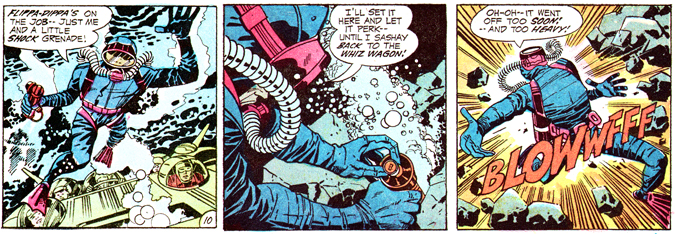
Flippa Dippa at work, He didn’t do much, but he did it well except explosives expert
I think the same can be said for all the other black characters found in the Fourth World. Vykin-the Black, Shiloh and even the Black Racer never had roles or even story arcs that played up their “blackness”, yet I don’t feel them as tokens. They did their parts and participated in the tales. Flippa was never all that important, but he was as important as Big Words, or Tommy. Scrapper seems to have been the only real standout in the Newsboy Legion. Perhaps it is to Kirby’s credit that he never made their blackness a part of the series. They were accepted as equals –though minor- by everyone. To Kirby black characters were as normal as Asian (Sonny Sumo) Indian (Wyatt Wingfoot) dwarfs (Oberon) or any other minority, yet he never made a spectacle or pointed fingers at their differences. They had become just another element to his tableau, a little color perhaps, but regular Joe’s. The face of villainy was all its own. He was an indifferent species-neither black nor white, Eastern or Western, evil stood alone, just hard and nasty. Jack did make an important issue of race, and prejudice, but it was at the expense of a totally new race living on New Genesis called “the Bugs” and kept down by the supposedly superior race of super-beings led by Highfather. –Kirby’s nod to the curse of America. For the rest of Jack’s career, he managed to always fit in black characters into his bigger stories. From the Falcon, to Black Panther, Big Masai, and Major Klavus, Jack’s world was multi-cultural. (of course one could say it was multi-special also as he used many anthropomorphic characters as well)




Starts out with a bang and a laugh
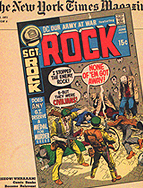 Oh relevancy!!! Has ever a good word been so abused in mainstream media? Whenever journalists, or reporters try to explain the evolution of comics they always spout that the newer comics have become relevant—a reflection of the more complicated ways of real life, and acknowledging the dirty underbelly. It’s not that they are wrong, but they always back up their assumptions by pointing out mega-steroidal hulks or hyper-pneumatic women that fly and are invulnerable, while wearing underwear and cut-out tops. As if that’s reality. On May 2, 1971 an article appeared in the prestigious New Yorker magazine dealing with the new depth and relevancy of comic books, written by Saul Braun. While spotlighting a harrowing Joe Kubert-drawn Sgt. Rock story and Stan Lee’s battle with the censor board for a Spider-Man arc, and O’Neill’s and Adams’ Green Lantern/Green Arrow tales, it also interviews Jack and talks about the New Gods. The article was poorly titled “Shazam! Here Comes Captain Relevant.” I think Jack liked the spotlight, but Jack wasn’t overwhelmed with comics taking on deep problems. He thought they lacked the space and timing to do it right. Graphic Novels were not around yet.
Oh relevancy!!! Has ever a good word been so abused in mainstream media? Whenever journalists, or reporters try to explain the evolution of comics they always spout that the newer comics have become relevant—a reflection of the more complicated ways of real life, and acknowledging the dirty underbelly. It’s not that they are wrong, but they always back up their assumptions by pointing out mega-steroidal hulks or hyper-pneumatic women that fly and are invulnerable, while wearing underwear and cut-out tops. As if that’s reality. On May 2, 1971 an article appeared in the prestigious New Yorker magazine dealing with the new depth and relevancy of comic books, written by Saul Braun. While spotlighting a harrowing Joe Kubert-drawn Sgt. Rock story and Stan Lee’s battle with the censor board for a Spider-Man arc, and O’Neill’s and Adams’ Green Lantern/Green Arrow tales, it also interviews Jack and talks about the New Gods. The article was poorly titled “Shazam! Here Comes Captain Relevant.” I think Jack liked the spotlight, but Jack wasn’t overwhelmed with comics taking on deep problems. He thought they lacked the space and timing to do it right. Graphic Novels were not around yet.
A decision was made to introduce Kirby’s new series in Showcase Comics. Cover artwork was even readied. Kirby objected because it would make it seem like this was a try out series, rather than a 100% full confidence project. Carmine relented. Kirby began unleashing his new books from scratch, rather than an insert in an existing series. The early issues of Jimmy Olsen would introduce Jack’s larger tableau. It seems that Jimmy has uncovered evidence of Earth becoming a pawn in a larger war between two distant worlds. Jimmy and the Legion and the Guardian would take the fight to aliens working underground to sabotage the world. In the background running the show was the ominous Darkseid (dark-side) from the planet Apokolips, who was infiltrating Earth to


Stan in full hairsuit regalia – shades of My Lai a year earlier
find what he called the anti-life equation. With this formula, he was hoping to be able to enslave the universe with its mind control ability. As a subplot Jimmy has uncovered a secret military research base which is working on top secret projects alongside aliens and other assorted weirdoes. Jimmy Olsen threw out more concepts per page than any other comic in history. Kirby’s mind was in overload and Kirby’s kitchen sink attitude made for an amazing journey. Don Rickles the legendary insult comedian even made a cameo appearance. Jack must have been laughing his tuckus off while drawing this series, and we were the hockey pucks.
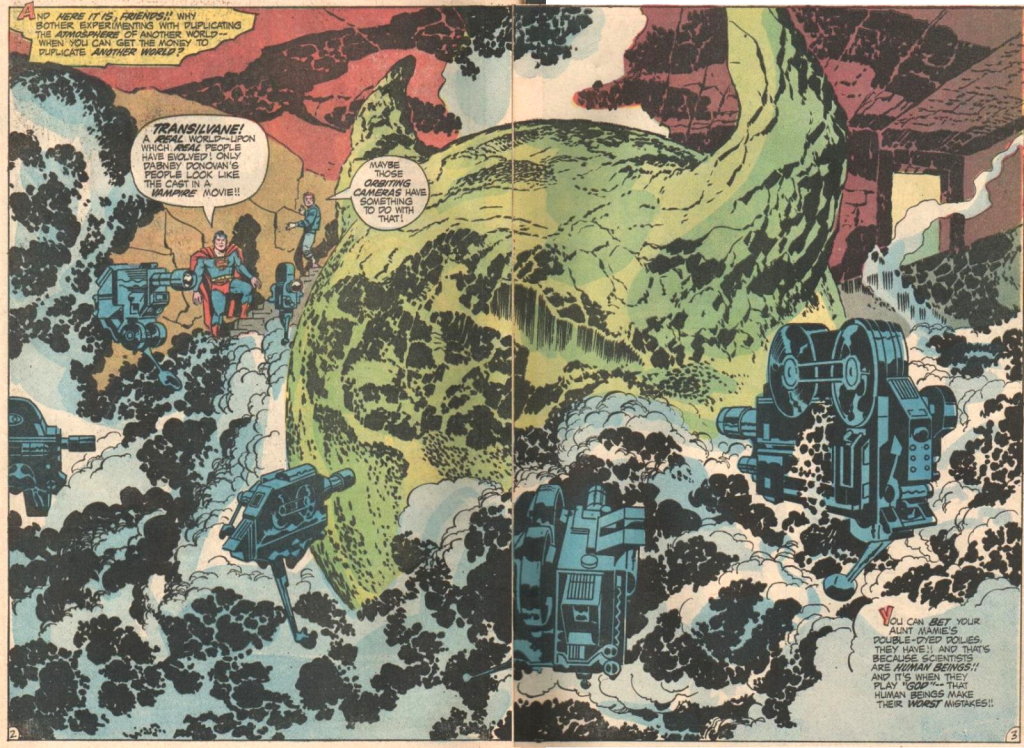
A video world pre-MTV
Trouble arose almost immediately, when the DC office received the first Jimmy Olsen pages someone remarked that the faces of Superman and Jimmy looked like Jack Kirby drew them and this wouldn’t do. The public was used to seeing Supes and Jimmy in a certain manner and that couldn’t change. Their first idea was to have Vinnie Colletta, the inker make them on model, but were dissatisfied with his version so they had longtime regular Al Plastino redraw the figures. Thereafter others like Murphy Anderson or even Neal Adams would make the corrections. Jack was furious, why hire him if they don’t want him to do his style. But this wasn’t aimed specifically at Jack; other DC artists had their figures changed for the same reason–to keep a character on model. While at Marvel, Stan had Wally Wood draw the Daredevil figures in an issue of Fantastic Four, and Jim Steranko drew Nick Fury’s head in a Captain America issue. John Romita would often ghost Spider-man in issues he was guesting in. Though the practice was accepted as standard procedure, Jack didn’t like it. With hindsight it doesn’t appear that Kirby’s version were way off line, the characters seem perfectly identifiable, but image was everything back then and Kirby had to accept it. To the readers it must have seemed strange with Kirby’s hard bulky forceful images next to the soft, cheeky old style Superman. Jack learned early that a change in location didn’t mean an end to outside editorial interference. It should also be mentioned that DC expanded the Fourth World into Lois Lane’s series.
The first new series to hit the stands were New Gods, and The Forever People, followed a month later by Mister Miracle. All played important roles in fleshing out the cosmic war that was taking place, but each came from a different angle. The New Gods represented the frontal, direct battle between the two worlds that chose Earth as its battlefield. The New Gods starred the dark brooding Orion, raised on the peaceful world of New Genesis, but tasked by their leader Highfather with the fearful role of the warrior who must take the fight directly to Darkseid.


Forever People #1 redrawn Superman – Carmine Infantino editor
But Orion lives a secret that will affect everything. Orion is of two natures, the gentle scion of New Genesis, and a horrible unmanageable beast given to berserker type rages while in battle. This dichotomy is controlled by his “mother box”; a small computer like machine that becomes literally a part and presence with the person who owns it. Orion is often partnered up with the personable Lightray whose bright personality stands in stark contrast to Orion’s dark warlike traits.
The Forever People were a group of young kids who decided that they wanted to sit this war out. They decided to stay above the fray much like a large sector of American youth decided to sit the Viet Nam War out. But unfortunately, Darkseid wouldn’t let them. The series also featured what I thought was a huge contradiction. These children of peaceful coexistence could meld into a singular entity with a bad disposition and ass kicking attitude. It always seemed silly to on the one hand to show conscientious dissenters suddenly morph into a militaristic personality to wrap up the villains. Was this secretly Jack saying that peaceful methods don’t work, and brute force will always trump evil when peace fails? Interestingly, this character The Infinity Man disappeared after just a few issues. Jack did have plans for this group, but I think he lost his way.



Mister Miracle Lightray and Big Barda round out the New Gods
“I had a black man, Vykin the Black and he was part of the epic. I filled it with the people of the Sixties, and I called them the Forever People, because they seemed like Forever People to me. They were a new step, a new social event in the epic of America. The Forever People were the young people of their time; beautiful, active, highly intelligent and wonderful material for stories, I used the young people of the times; the times themselves became the backdrop of my stories.”
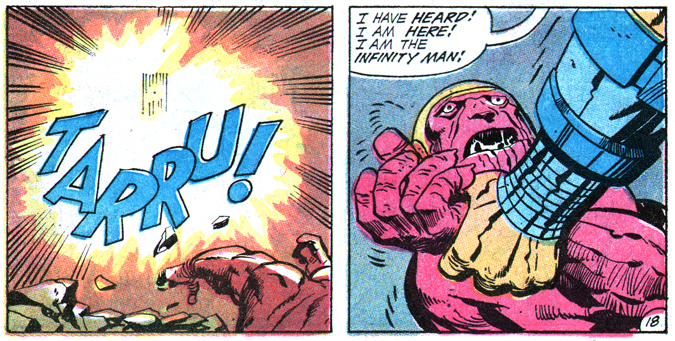
It seemed that one of the kids, Beautiful Dreamer, had a connection to the anti-life formula and Darkseid wanted it. Chasing Darkseid and Beautiful Dreamer to Earth, the group makes a rude and noisy landing that attracts the attention of Darkseid’s minions, plus those of Jimmy Olsen and Superman. Superman catches up to the group just as Darkseid’s underlings attack the group.
Aid comes with the help of Superman and a guardian entity that is formed when the group members touch a mother box and call out “TARRU” This entity known as the Infinity Man is stronger even than Superman and he easily dispatches the villainous monsters. Yet Superman has caught a glimpse through a Boom Tube of a far off world known as Supertown, and wonders if he has a past connection with it.


Kirbytech borders – a happy group
When he requests a doorway to Supertown the kids try to talk him out of going, they tell him that the coming battle will be on Earth and he is needed there. Yet he is determined to go. So the group opens a “boom tube” –a portal across dimensions and Superman enters, but as he nears his destination his doubts take over and he realizes that he can’t abandon Earth, and he returns. Jack’s Superman was one of doubt, and questions. He was sort of a stranger in his own land. He was truly an alien in search of his own history. This short synopsis can’t even begin to relate all the crazy concepts that Jack packed into these stories, but they were never ending and breath taking. All these characters from the two warring worlds had super powers. Despite their attempts at pacifistic avoidance of the war, the Forever People were constantly drawn in and forced to choose sides.
The third book, Mister Miracle revolves around one Scott Free. Born in freedom, yet raised in Apokoliptian slavery, he dreams of escaping from that horror world to a place he can live in peace. This book mirrors the many refugees from Communist countries who faced death to escape to the West. The book opens with Scott actually escaping to Earth, where he meets up with an itinerant entertainer who magically escapes from imprisonments of all kinds. Much like Harry Houdini, this man challenges death daily, and miraculously escapes. But Darkseid is never happy about losing a disciple and he continually attempts to trap Scott Free and return him to Apokolips. When the elderly magician is killed, Scott Free takes up the mantle of Mister Miracle the great escape artist and using his “mother box” he starts his own show where he escapes from the most mind dazzling collection of death dealing devises ever seen, while also escaping from the crazy traps that Darkseid and his underlings set for him.



Steranko – man of many talents
It was not a coincidence that this character was inspired by young Jim Steranko who once had a stage show where he escaped from manacles, and chains and other imprisonments. In a private New York dinner, Jack teased Jim Steranko about what he had started. A surprised Steranko was shocked when a DC editor showed him the proofs of Mister Miracle and informed Jim that Scott Free was indeed Jim Steranko.
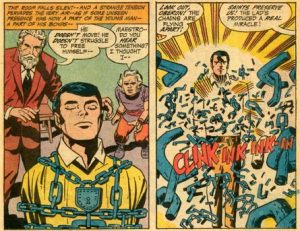
“Mister Miracle would have to join Orion in his battle to forever rid themselves of Darkseid in some way.” “Oddly enough, it was Darkseid, the most evil of the characters that brought the others together. It was Darkseid’s dealings with all of them that became the manner in which I could demonstrate how we all deal with evil. I made it as realistic as possible, and the reader could identify with the characters. The book itself blossomed into many others, and became an epic in itself for years.” Good guys usually triumph over bad guys. Bad guys, no matter how clever they are, operate outside our laws. Sooner or later, they must make a mistake that will bring them in contention with that law, and then they will fail.” Jack told an interviewer.


Jack Kirby’s Ricky and Lucy – It wasn’t always love and roses
The four books intersected, but rarely connected directly, the main connections were that Darkseid was the common villain and the search for the anti-life equation concerned them all. There was never anything like this done prior to Kirby’s effort. Kirby had a vision for this series as having a definite conclusion rather than an on-going endless series of books. There would be a reckoning. More important, Jack had added passion and justification to his palette.


Rock hard and nasty – fully articulated
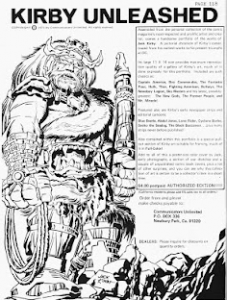 Just after Kirby started the Fourth World series, his son Neal graduated from Syracuse with a Business Degree. He moved back to California and brought with him his young wife. Neal and Steve and Mark hit it off immediately. After the debacle at Marvelmania had ended, they were still excited about the possibility of marketing items relating to Jack’s art. Over the dinner table they decided on putting together a portfolio of Jack’s art through the years, plus add in a simple biography. The result was Kirby Unleashed. It featured many examples of Jack’s early art, most of which had never been seen by the public before. Plus it had rejected pages, and production pages from recent series, and a preview of Jack’s new New Gods books. With a biography by Mark Evanier, and the graphic work by Steve Sherman.
Just after Kirby started the Fourth World series, his son Neal graduated from Syracuse with a Business Degree. He moved back to California and brought with him his young wife. Neal and Steve and Mark hit it off immediately. After the debacle at Marvelmania had ended, they were still excited about the possibility of marketing items relating to Jack’s art. Over the dinner table they decided on putting together a portfolio of Jack’s art through the years, plus add in a simple biography. The result was Kirby Unleashed. It featured many examples of Jack’s early art, most of which had never been seen by the public before. Plus it had rejected pages, and production pages from recent series, and a preview of Jack’s new New Gods books. With a biography by Mark Evanier, and the graphic work by Steve Sherman.
Neal did the marketing under the business name Communicators Unlimited. It was a well packaged product that did well at first, and eventually made a little money. It wasn’t perfect, there are mistakes in the bio, and the art choices are questionable at times, but it is and was a great introductory item to the world of Jack Kirby.

They followed this up with another portfolio called The Gods, which represented the Norse Gods in a different way than the Marvel versions. These were inked by Don Heck and colored by Jack. Jack mistakenly claimed credit for inking when he misunderstood a question by Greg Theakston and confused inking with the coloring—since the colors are called inks.




New versions of old characters
With the two portfolios in hand plus other small items they had made up, they attended a Comic Convention in New York. The convention gave them a private room and they opened for business. Neal said they were amazed, the stuff was flying off the shelves. They thought they had struck it rich.
Working at DC had its stodgy side—one called it an almost mausoleum in its efficiency, but there was one item that always woke them up. Alan Kupperberg was a utility man helping out in inking, and production chores. He remembers;
“… normally, only two events in the staid course of the DC universe would, like a giant rogue comet or invading singularity, disturb the magisterial and usually unalterably eternal orbits at DC Comics. The arrival of a new Joe Kubert Tarzan book; and the other JK– Jack Kirby’s — latest “special delivery.” Even hardened and cynical long time production department grunts Morris Waldinger and Joe Letterese would join the gaggle and goggle in appreciation as each new Fourth World episode unfolded.”
“Funky Flashman absolutely made waves the moment it arrived in the office. If my memory serves me, within a day or so of its arrival, a certain Houseroy had paid an undercover visit to DC and had a chuckle reading this now “infamous” tale.”
But all was not love and kisses at DC. Along with Jack’s new forcefulness on inkers, he also started making demands of the colorists. DC’s coloring crew had worked with a strict independence, and the choices had been left up to Jack Adler and his crew such as Jerry Serpe, etc. But Kirby had his own ideas about coloring that had evolved over the years as he had occasionally provided color guides for selected covers. There had been a huge dustup when Mister Miracle #1 was printed with the wrong colors for the uniforms. This resulted in a heated battle over the phone between Jack and Jack Adler. Perhaps Jack’s demands had been ended with an “I am the editor and what I say goes” type of statement. Jack Adler was a nice guy, but did not take interference well. Jack’s insistence and interference with Adler reached the point that Adler called him an “egotist” –though probably not the correct term Adler was looking for. Jack’s demands were not made from ego but from his own artistic vision. It wasn’t Kirby pushing his auteurness, it was the director looking at all techniques and processes. He wanted a better, perhaps more personal product, not more acclaim. Adler was somewhat contentious and possessive about the coloring aspect and hated artists interfering with his realm. Good thing he never worked with Jim Steranko who wanted 100% control of the process.
Kupperberg notes.
“Wonderful, funny, patient Jack Adler ran DC’s coloring department, among his other duties. When Tommy Nicoletti, Jerry Serpe or Paul Reinman would deliver the color guides for a Kirby book, Adler would review it, as he did all their efforts. Adler would often “throw” a YRB2 (red brown) or a YBR2 (dark green) into a panel behind a three-quarter character close-up with an open background. A touch as small as this would invariably make an already sizzling Kirby page pop like a firecracker.”
Kirby started to collect a small group of admirers who came to visit often at the Kirby casa. Like moths, this group of young men was drawn into Kirby’s flame. Among this group was a budding artist named Dave Stevens and his best friend Scott Shaw. Dave grew up loving dinosaurs and spaceships and drawing them on anything. He would hang around Jack, and while the others would pester Jack about office politics, and company ways, and the latest story, Dave peppered him with questions about art materials, and tools, and the nuts and bolts of creating comic art. Jack began mentoring Dave and encouraging his work. Dave would proudly show Jack the things he was working on—such as toy designs, appliances, and other sundry items. Jack boasted that he should be doing commercial art for magazines, but Dave protested that he wanted to do sequential art like Jack.
Mark Evanier recalled seeing Dave at Kirby’s:
“Dave was truly one of the nicest people I have ever met in my life…and the most gifted. Our first encounter was at Jack Kirby’s house around 1971 when he came to visit and show Jack some of his work. As I said, Kirby was very encouraging and he urged Dave not to try and draw like anyone else but to follow his own passions. This was advice Dave took to heart, which probably explains why he took so long with every drawing. They were rarely just jobs to Dave. Most of the time, what emerged from his drawing board or easel was a deeply personal effort. He was truly in love with every beautiful woman he drew, at least insofar as the paper versions were concerned.” (Dave was married once…for six months to the prolific movie actress Brinke Stevens-another Bettie Page look-a-like– and she retained his last name after they divorced.)
Dave’s career wandered into another area when he began doing work for movies, such as storyboards and some design stuff. He also picked up some animation work with Doug Wildey and would join the Wildeys and Kirbys at social functions. Russ Manning gave Dave some work on Tarzan. But his favorite was the few times he would ink Jack’s cartoons for the San Diego Comic-Con. Dave often sat with Jack at the con and marveled at Kirby’s patience. When asked what he remembered most about Jack, Dave said; “ (His greatest lesson) was probably about being gracious to fans; to people who really impose, and don’t go away and don’t have a clue—and yet Jack would always take the time, and he was never rude to anybody. He treated them all with respect.”
Kirby had some other ideas he wanted to try. He was interested in breaking out of the 20 page, small pamphlet mode and expand into larger magazine sized books where he could have more freedom to make the stories more adult. Since the comic code authority had no control over other magazines, the artists had the ability to venture into more adult territory. Warren Publishing was having success with Eerie, Creepy and other mags. Even Marvel had ventured in with a couple Spider-Man magazines. Other publishers stuck their toes in also. Jack proposed a handful of concepts from which two were given the go ahead. The first to see print was titled “In The Days of the Mob”, where once again Jack would venture into depression era crime. The stories were eerily reminiscent of his Crestwood books like Headline and Justice Traps the Guilty. The second book returned Kirby to his horror days as Spirit World retread Jack’s Black Magic and Strange World of Your Dreams. The books were published by Hampshire House, a small imprint of DC and received a very low distribution and virtually no visibility on the stands and died after one issue each. It has been speculated that DC had no real desire to see these books succeed and made sure of the low distribution. Their chosen genres certainly ran against the current graphic tide. Horror and Crime had both lost their lustre.
The books were very well done and the art was superb Kirby, but the subject matter and themes were purely old school– been there done that–and really offered nothing new or exciting to the readers. For wanting to hit a more mature audience, the actual content was Ivory Snow pure.


In The Days of the Mob splash, no loss of dynamics – Spirit World eerie and atmospheric
Kirby had produced stories for a second horror issue and with the cancellation; they turned up in several of DC’s horror titles. Several other concepts such as Soul Love, an African American centered romance book, and True Divorce Cases were rejected as unsellable by the company. There was even a pitch for a magazine tentatively titled Uncle Carmine’s Fat City Comix – a sort of underground/ Rolling Stone / National Lampoon pop culture rag. It also was aborted.


Unpublished attempt at more risque adult fare – Was Kirby responding to Jane Fonda?
NASA was planning a huge step in man’s cosmic exploration. With the launch of Pioneer 10, we would be leaving our small solar system. Man was going to worlds unseen. A science writer named Eric Burgess came up with an idea that Pioneer should carry a message to any alien intelligence that might come across the spaceship. He approached Carl Sagan, a fellow scientist and writer, who had lectured about communication with extraterrestrial intelligences at a conference in Crimea. Sagan was enthusiastic about the idea of sending a message with the Pioneer spacecraft. NASA agreed to the plan and gave him three weeks to prepare a message. Together with Frank Drake, the founder of SETI, he designed the plaque, and the artwork was prepared by Sagan’s then-wife Linda Salzman Sagan. The first plaque was launched with Pioneer 10 on March 2, 1972, and a second followed with Pioneer 11 on April 5, 1973.
The design of the plaque was not unanimously accepted, and The Los Angeles Times ran an article asking other notable artists and writers for their preferred version of the plaque. Among those asked were Peter Max, and underground artists Victor Moscoso and Robert Williams, Virgil Partch and Brit Allen Jones. Jack Kirby was one of those asked. In a Sunday supplement called West Magazine, dated Sept. 10, 1972 they published the results. Jack’s submission showed a man and woman as colorful happy super beings. Kirby wasn’t thrilled that such an important concept was left to just a few individuals, instead of a national debate. He explained that he was wary of sending any information about humanity. His fear was, as he put it, “who would come knocking, the trader, or the tiger?” So it was better to show man as capable of defending itself.
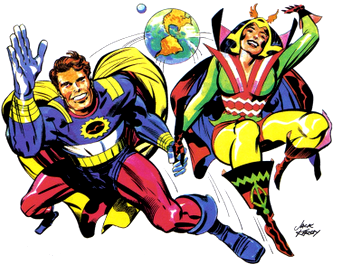
Kirby Kolors watch out tiger!
Early on all the DC books were inked by veteran Vince Colletta. Colletta came out of the Alex Raymond school of romance illustrating and he was known for a very fine line and scratchy textured feel to his inks. His specialty was texture, he wanted the readers to fell the difference between cloth, and leather, or fur or skin—he gave each its own technique—that’s why his work on Thor, with its naturalism seemed so successful. He had been inking and drawing romance books, and then Thor for years at Marvel. Many readers felt that this was the wrong style for inking over Kirby.
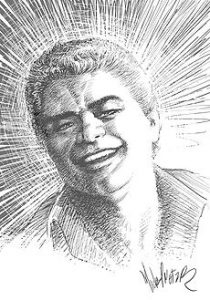
Vince the Prince
Kirby had reached an impressionistic style full of hard slashing lines and expressionistic squiggles and bold backgrounds full of dynamic bursts of energy named Kirby krackle. Truth be told, Jack had long since stopped worrying about texture, it seemed all materials were treated the same way. It didn’t matter if the person was wearing a natural material or a metallic suit, Jack drew folds, or sinew the same way—hard slashing squiggly lines that dissected the body. It was left up to the inker to decide whether or not to differentiate between skin, material or metal. Colletta’s lightweight inks never seemed to capture the full dynamics of Kirby’s boldness. Colletta also had a maddening habit of erasing background characters and simplifying architecture by turning Kirby’s magnificently ornate architecture into little square grids and checkerboard facades. He also would simplify faces and make all the women look the same; beautiful, but plastic. But Vince was not without talent and fans—chief among them the editors –who often called on Colletta and his band of merry inkers when jobs were behind schedule.
Mark Evanier, and Sherman would look at the stats and compare then to Kirby’s originals and blanch at the changes Vince made. They would show them to Jack and campaign for Jack to fire Colletta. Jack was wary, he hated that type of confrontation and the thought of taking food out of a fellow artists’ mouth reviled him. But finally he had enough and made a visit to New York and confronted Colletta. Vince made it clear that he wasn’t changing his operation of coached associates for anyone, and perhaps Jack should simplify his pencils so that an inker could do them faster. The outraged Kirby went into the DC offices and demanded of Carmine that he replace Colletta with Mike Royer, the inker he had met in California. Carmine commiserated with Jack, but Colletta was a very valuable inker. He was the inker that the editors turned to when they were behind schedule, as Colletta and his team could do a whole book over a weekend. A compromise was reached; Colletta would remain on Jimmy Olsen, the in-house book while Royer was given the other three titles.
The results were so dramatically different–like night and day. But the response was mixed. Many people loved the softness and textures that Vinnie added, while others wanted the full abstractness of Kirby’s new style. The initial reaction was negative, and in one of the few arguments between Kirby and Evanier, Jack blew up and blamed him for the response since he was the one who pushed for Royer as a replacement. His anger soon passed; personally Jack was thrilled with Royer. Having the inker so close allowed Kirby to make sure that what was inked was what he drew, it also meant less art changes from New York. One time Royer prettied up the face of Big Barda; a female warrior that Jack drew solidly. When Jack saw the pretty face he immediately cut it out and redrew the face he wanted, scolding Mike and telling him never to change anything. Royer understood and is considered the inker most true to Kirby’s pencil. Unfortunately, Mike was not the most fluid inker at the time and his early works seem messy and overwrought. The demand to never change anything meant that little mistakes and bad perspectives that more mature and competent inkers would have corrected remain in Mike’s inks. Over time Mike improved drastically to where his precision almost rivaled Joe Sinnott.


Greg Theakston’s second edition – deluxe death defiers redux
Yet it should be noted that the early 70’s saw the introduction of a new breed of pencilers, with a style of exquisite illustration. These artists such as Mike Ploog, Bernie Wrightson, Jeff Jones, and others grabbed the attention and superb cartoonists like Kirby, or Ditko and Beck suffered with the young buyers. The change in styles made Kirby seem old and outdated. In the fans eye, Jack Kirby was becoming passe; a victim of time and tide. Some pros took to unfavorably comparing him to the then hot Neal Adams, and saying Jack was the past while Neal was the future. (It should be mentioned that Neal Adams, while unique never had a successful run on any given comic, while Kirby never failed. Neal drew pretty pictures, Jack told stories.)
But Jack had his fans. Carmine once admitted; “The kids at Yale think Kirby’s new books are more tuned in to them than any other media. They’re reading transcripts from NEW GODS over their radio station. The Kirby books are a conscious attempt to show what things look like when you’re out where the kids are. The colleges, the influence of the drug culture. We’re showing them basically what they’re seeing. We’re tuning in to what they’re experiencing.”
It is interesting that at this time Jack Kirby finally became picky about his inkers. Inking has always been a part of the process. But Jack always figured that his ability as a penciler was so strong that an inker could not destroy his meaning. His many inkers over the years had many styles and techniques that they added to Jack’s drawings. Whether it was Joe Simon’s dark and scratchy hay, or Al Williamson’s beautiful light airy illustrative flourishes, or Wally Wood’s dramatic shadow/sheen, it seems Jack’s stories shone through. At Marvel, Stan paired Jack up with a varied crew of fellows and told them to add their personalities to Jack’s pencils and make the finished product collaboration. To Stan, the inkers were as important as the penciler to the final product, so a Dick Ayers added a roughhewn organic line, while a Steve Ditko made everything dark and creepy, a Vince Colletta softened and texturized as Joe Sinnott hardened, and intensified the work with clear, hard, shiny lines. None of these were wrong, though some might say that Colletta’s softness was not what Jack drew. It should be emphasized that for most of Jack’s career, the inkers were chosen by the editors; they were controlled and judged by the editor, not the penciler. Their job was to prepare the work for coloring and printing, not to impress Jack. Later in life Kirby worried about inking, and coloring, and preferred those that followed more precisely what he drew. He wanted trueness, not added personality. So we see him going more to Mike Royer or Berry. Jack had earned this right though some may claim that the product lacked style and personality that came from inking flourishes. Did not the FF look better under a Joe Sinnott rather than a George Roussos? In fact, Jack Kirby actually took little flourishes from the inkers to make his work look better. These arguments will continue for all times. And the answers will always be subjective–purely dependent on the individual’s preference. But inking does have some fundamentals that all the inkers depended on. Artist, friend and occasional Kirby inker, Greg Theakston explained in an article in Amazing Heroes #100. Titled “A Look at Technique”, Greg tried to explain what an inker needed to do over Jack Kirby; he used a drawing of a god, Heimdall, done by Kirby and Don Heck in the late 60’s as a guide.
“As a basic rule, the inking is broken into three strokes.
1) “Holding lines”- Heavy lines that define the overall shape, with accents to move the eye, and at the same time, strengthen the form. To see the holding lines, squint at the drawing. (Chic Stone used the heaviest holding lines, they have been called coloring book drawings because the lines were so distinct – Colletta’s may have been the finest. – ST)
2) Decorative lines- Medium lines that define secondary shapes on a major form, or lines that decorate the major form. (such as costume lines and muscles)
3) Detail work- Fine line-work used on important intricate forms; also used as textures. (note scales on tights, detail work can be heavy where the detail is more prominent)
What amazes me is the weight of the “holding lines” on the legs, hip, and cape. How many of today’s inkers/artists would dare to use such a line? It is heavy but not crude, and it also manipulates our eye back to the head. The blacks are spotted in the cape, and really push the figure forward (called spotting- it really refers to mass blacks of any shape that can be used to highlight and direct the action) Rather than black spots, Heck has given the shadows a fur texture. All the fur work leads your eye to the warriors head.
The shadow work on the right leg is very strong, and adds extra support to the lower leg. Well-spotted blacks within give an object strength and support. (make the leg appear strong enough to carry the figures weight)
The composition is the “big O” helped by the cape, stripes on shoes, outer axe blade, strap, and up to the head.” – Greg Theakston
While I might agree or disagree with some of what Greg put forth, I think he captured the main points. ( I tend to put less weight on the “leading” role Greg thinks is so important, I might also have talked about the role of cross-hatching as opposed to feathering, or blocking as an inking choice for shadows) Inkers must constantly choose the weight and thickness of their lines to help shape the character for proper coloring. The inkers must also decide how to interpret the pencilers gray areas. An inker like Colletta would always choose to make shadows soft and shapely rather than Royer’s choice of solid black areas. The important thing, as Gil Kane and John Romita noted was that Jack supplied all of those answers, the inkers job was to follow Jack’s choices, not add in their own personal choices. Jack wanted someone to follow his suggestions, not come up with their own. Basically, it’s a philosophical question. Is the inker a facilitator or an equal partner in drawing this picture? It’s a question that for most of Jack’s career he didn’t care the answer, but as he got older, he considered inkers as facilitators-just part of the printing process, not the thinking process. Jack would explain that all the storytelling choices were made before the drawing even starts, after that, it’s all process.
Mike Royer gave Jack what he wanted- some bad, extraneous and sketchy lines and all. To many people, they would have preferred seeing some of Mike’s style and personality also. Stepping out of the authorial role, my preference has always been the collaborative method where the inker is considered an equal person in the process- give me a Wally Wood, or Joe Simon over an aper anytime. It is interesting that at an even later time, Jack allowed Mike Thibodeaux to ink. Mike always added in his patented circular, florid lines to the drawing. He couldn’t ink without adding his personality to the mix.


More Kirby art and Green Arrow plays along
In the early Seventies, Mattel , the toy company came up with a series of comic related puzzle games. They would feature the Lone Ranger, Tarzan, and Superman. Alex Toth was scheduled to supply the graphics, but when he couldn’t do them he recommended his California neighbor Jack Kirby. The art was classic Kirby doing three characters that he had never really done previous, except for a few panels of Superman in the Jimmy Olsen comic. Mike Royer inked the drawings and on Superman they once again had the head redrawn by Murphy Anderson. One of the Superman drawings appears to be Superman on Super Town. What an amazing chance to see Kirby on Tarzan, and Lone Ranger. There had been other chances where Kirby might have done classic pulp, and radio characters, but this was one of the few times to actually materialize.


Impostor heads and an early Devil Dinosaur
Another interesting commission came from Pro! Magazine– an in-house magazine for the NFL. Kirby was asked to do two drawings of a cosmically charged futuristic football game. These magnificent works of art also feature Kirby’s unique color palette. The art is surreal, and garish, and futuristic.
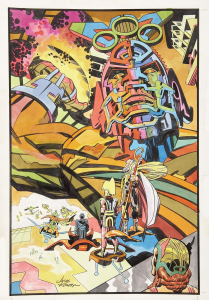
Kirby throwing the bomb
In most lives, especially that of a freelance artist, there are those strange projects that come along and for a period take up ones time and creativity, and then quietly disappear for reasons of their own. The little work product created gets thrown into the dead drawer where it sits until many years later, an inquisitive family member comes along and reopens that long lost drawer. In 1971, American International pictures released a horror movie called the Abominable Dr. Phibes, a scary, slimy gothic horror film of revenge—notable only for the scene chewing vitality of Vincent Price, and the Phantom of the Opera rip-offs. It was a modest film of no real repute, but it managed to make the studio some money so a follow up was ordered. The second film released in 1972 was called The Rise of Dr. Phibes, where Price reprises his role of the horribly scarred Dr. seeking revenge on those who killed his wife. Most of the writing was by William Goldstein, though the second feature was bastardized by other writers. This sequel also made money and Goldstein tried to sell the premise for a TV show.
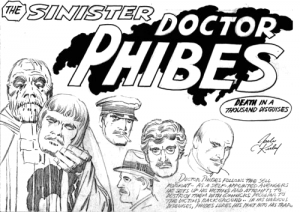
Jack Kirby was hired to produce some presentation art for the show to be called The Sinister Dr. Phibes. Only one sheet exists and that was found years later by Jeremy Kirby going through his granddads things. Jeremy speculated that it was a possible presentation piece for the movie which would put it circa 1971.
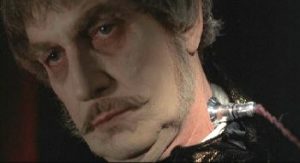
Vincent Price under the mask
Historian William Maynard places it after the second movie for a re-named TV pitch which would place it in 1972-73 which seems more likely given the name change. The piece was partially inked and lettered, most likely by Mike Royer who had taken over most of Kirby’s inking by this time, plus the lettering and logo design match up to Royer’s pattern. The piece was never finished as it most likely was shelved in mid-production-much like a later Prisoner series. It’s not known if this was a for gratis piece or if he was paid for his participation though short lived.
Later, another artist, Jay Stephens, after seeing the rough sketch finished the work; he re-did the title back to the original blood dripping movie title and formatted it to the Kirby style of the early 70’s. He added some muted coloring and produced a very nice sample of quasi-Kirby art. The corner accents are not something Kirby would have done—his decorative bits were more geometric and technical. I do like how the new artist re-used the black cloud letter background behind the new art in a more muted color. The new inker was very faithful to Jack’s original pencils and he captured the creepiness of the characters-though I wish the mask was more Vincent Price-like, and the added teeth to the monster weren’t necessary. Placing Jack’s name in a circle was something Jack did often in the early 70’s. All the details of how this piece came about will probably never be known, but it is an interesting look into the often crazy world of the freelance commercial artist. Hopefully other one-off pieces will show up and help fill in the magical career of Jack Kirby.
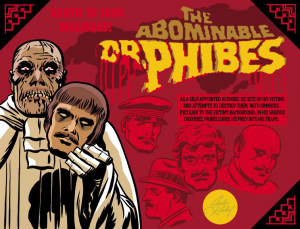
The initial sales returns for the Fourth World books were encouraging. It seemed that many a Marvel Zombie crossed over into enemy territory. It’s been reported that the first issue of Kirby’s Jimmy Olsen set a new company record for most improved sales from one issue to the next. Unfortunately the sales did not continue to impress; they slowly slid southward. Some of the problem was DC’s. They got into a price pissing match with Marvel and got burned. Their higher pricing caused a great drop in the whole DC line and almost cost Infantino his job.(similar to what happened to Dell) Other problems might have been Jack’s, such as never giving a new reader a comfortable place to jump in at, and not giving the characters back stories and histories. (I’ll talk about this in more detail later)
In 1972, a small toy company leased the rights from both DC and Marvel to create a new line of action figures. Mego Corp. was a little known company that had offered an 8 inch fully poseable doll named Action Jackson. The toy made no ripple in the market, but Mego was convinced by a merchandiser that the body cast could be used on a new line of super-heroes. They paid $50,000 for the rights to 4 DC comic characters and released them in 1973 to much acclaim. Batman, Superman, Robin and Aquaman were a whopping success. Mego quickly acquired the rights to several Marvel characters. Spider-Man and Captain America appeared later in 1973 using Jack Kirby art on the advertising.


The next couple years would see the addition of more old DC and Marvel characters such as Hulk, Iron Man, Thor, and the Fantastic Four-many using Kirby’s artwork on their packaging. This series title World’s Greatest Super–Heroes became a marketing miracle that catapulted the company to the height of toy companies. The quality of the sculpting and the costuming was top rate and the packaging was colorful and eye-catching. They added to their line with a series of banks, and play sets, and accessories. The action figure became a staple of the toy industry. Despite the great fees, the artists never saw a penny. At the same time Marvel was using Kirby art to sell their merchandise, they released a series of hard backed books telling the history of Marvel Comics with the claim that all the characters were created by Stan Lee. If any mention of Jack Kirby was made it was as the lucky artist chosen by Stan to illustrate his characters. Jack Kirby was officially a non-person- as the cash registers rang upward. Kirby angrily took his copy and tore out all the text by Stan Lee. Roy Thomas commented; “I think once Jack left, there was a natural tendency to mentally downgrade his contributions, just from a practical viewpoint. Otherwise you’re giving a competitor credit. I won’t say how much of that was conscious and how much was unconscious, but it’s a natural tendency. At that stage, you’re doing it for hype, for publicity purposes and to do that, you don’t necessarily play up the guy who quits and gone to the competition.” It seems sad that DC did nothing to push Kirby’s new concepts, while Marvel kept regurgitating unaccredited, Kirby’s old characters and art. An Orion among the Mego figures would have been staggering.


I think DC told Jack his sales were slipping, and Jack responded by trying to make the books more dramatic. He attempted a cinematic technique that made the introduction of the stories jump out with dynamics. It has been called the opening triptych. The splash page is a beautifully rendered introduction to the hero in a dramatic fashion. Page two and three become a fabulous two-page splash that introduces the locale and wild environment that the hero is caught up in. These wide angle shots are simply beyond the pale; full of movement, details, and drama that immediately pulls the readers in. The quiet but dramatic opening splash page erupts into a maelstrom of action as all hell breaks loose. I can’t think of any other artist who has so confidently and imaginatively given us a peek into their nightmare visions. Jack actually used this on a couple Marvel books but increased use of this technique on and off for the next 5-6 years. These two page splashes leave no corner untouched as Kirby fills the whole page with action.





Kirby opening triptych – see the hero – see the hero in deep shit dramatic detail
Around the time of the seventh issues, there appears to have been an editorial decision to make a change in focus. In New Gods #7 Kirby presented the back-story for the whole cataclysmic civil war taking place. He showed how the two worlds had always been at war until a pact was made between Darkseid and Highfather of New Genesis. This peace pact was sealed by a trading of the two offspring. Thus Orion was actually born of Apokolips, and Scott Free was originally of New Genesis. The great secret of Orion’s personality dichotomy was revealed, and Scott Free’s ingrained desire for freedom was revealed. Over in Mister Miracle, Kirby gave us Scott Free’s life as a child on Apokolips, taught by the sadistic Granny Goodness, trained to be a military man and shown the light by Himon, the leader of the underground freedom movement and quite the escape artist himself.


Takes us back to the beginning
In Forever People, they decided to bring in another long time DC character to try to draw in the longtime DC fans that were still resisting Kirby’s magic. In 1967, DC had originated a new character named Deadman. He was a circus performer killed in action by an unknown assailant with a hook for a hand (Borrowed from the TV’s Fugitive) He was reanimated as a ghost by an occult being and quested with finding his murderer. Although created by Arnold Drake and Carmine Infantino, it would become recognized as a vehicle for Neal Adams’ dramatic art. Deadman became a fan favorite immediately winning Alley awards as best new strip and character. Despite its impressive art, the character failed to find public acceptance and soon was dropped as a series. But the editors constantly tried to find avenues to showcase this character. In 1972 the editors asked Jack Kirby to throw him into the Fourth World. Jack was not happy, but he relented and Mark Evanier used a quirk in Deadman’s history as a means to work him into Jack’s epic. But Jack had no knowledge of this character and asked for help.


Alan Kupperberg was Johnny on the spot:
“Deadman was to make his appearance in the Forever People and word came back to DC via Jack’s New York liaison, E. Nelson Bridwell, that Jack needed Deadman art and story reference. Being, at that time, the buttinsky of ALL time, my ears opened wide. “
“I volunteered to loan Jack my own personal collection of Strange Adventures. Off they went to California. And you’d better believe I got them back in pristine shape and in a timely manner. And you’d better believe I’ve still got them.”
“Of course, as a dyed-in-the-wool Superman fan, I’d long dreamt of a Kirby Superman. So I was as disappointed as everyone else when DC had artists Al Plastino and then Murphy Anderson, bring the famous Kryptonian physiognomy into line with the DC house style. Sometimes Superman’s face was “whited-out” with Sno-Pake and Vinnie Colletta’s work was re-inked. Sometimes the inked face was pasted over. Sometimes it was literally cut out of the page and patched in. Sometimes Vinnie left the face uninked and it was passed on to Anderson. Murphy regularly worked in the tiny, airless room DC set aside for freelancers use. Why ever and whatever way they were accomplished, I still feel these alterations were a sad mutilation.”
“In that same cramped room I watched Neal Adams as he inked, among others, the Don Rickles cover of Jimmy Olsen #141. I also marveled as Neal did his own covers for the book, and his glee in having a crack at his conception of “being” Kirby on the cover of Jimmy Olsen #148.”
“After business hours, Adams would often invade the deserted production room and pore over the latest Kirby originals, professing awe at the King’s raw power and artistic versitility.” Adam’s would exclaim. “I get overwhelmed at seeing that gutsy, ballsy thing, (Kirby’s iconography) I want to do that but I can’t.”
It seemed that none of the attempts helped and sales continued to decline. Some have hinted that it wasn’t so much as sales declining but the failure to reach good sell thru of the print runs. This doesn’t make a whole lot of sense since print runs are easily reduced when called for. If an issue sells regularly at the 300K level than readjust your print run from 400K down 325K and you suddenly have a profitable print run. Publishers are always adjusting print runs as sales rise or decline. Sometimes a small sell through is evidence of an over-optimistic print run.
Whatever the true reason, Kirby was taken off Jimmy Olsen soon, New Gods and Forever People were canceled with issue #11. Mister Miracle was changed from a piece of a large intermingling jigsaw puzzle to a typical super-hero title and continued for another year and a half. But this didn’t mean the end of Kirby at DC. As one series was canceled, he immediately produced another. Carmine wasn’t anti-Kirby, he was anti-Fourth World, he was looking for a breakout series from Kirby.
Kirby was devastated, he had given his all on these books, and couldn’t understand how they could have failed. There were rumors of DC editorial intrusions and back stage shenanigans that killed the books despite decent if not great sales. Kirby was afraid that Carmine was reverting back to his pattern of cancelling titles at first sign of bad sales. It was well known that Carmine was on a short leash, and Kirby thought he was jumping the gun. No matter what the actual figures, they were no threat to Marvel’s dominance. Rumors and articles in some fanzines actually claimed Kirby was leaving. In reality, Kirby had thoughts of jumping ship, but he had a contract.
Book writers Will Jacobs and Gerard Jones have another theory on the collapse of the Fourth World books and Jack response.
From The Comic Book Heroes (1985 Crown Publishers)
“Sometimes, perhaps, Kirby’s imagination went a little too far out (especially in Jimmy Olson, where vampires, Scottish Sea Serpents, and even comedian Don Rickles traipsed through the pages) ; but even then, all of his work blazed with the unmistakable Kirby verve. The Fourth World provided one of those rarest and most meaningful of moments in comic book history; a truly individual vision, free of trends and fads, of editorial policy and the demands of mainstream fandom. In those pages, full of archetypal power, explosive action, and bizarre invention, Jack Kirby—the man who had been both workhorse and maverick, street fighter, and mythic poet, Salesman and creative genius during all of comics most critical junctures—brought his tumultuous career to a dazzling consummation, and in the process created 3 of the finest series of their time.”
“For a while there seemed nowhere to go but up. The titles were apparently selling well, Kirby was committed to them, and their promise seemed boundless. Thus it came as a stunning blow both to Kirby and his fans when DC inexplicably canceled New Gods, and the Forever People after 11 issues(Nov 1972) and Mr. Miracle after 18 (Mar 1974) having already turned Jimmy Olson over to editor Murray Boltinoff (Apr 1972) The “titanic” struggle of New Genesis and Apokolips was left unresolved (With these cancellations Kirby felt a growing discontent with the standard business of comic book production, in which all of his great ideas remained the property of DC, and he gained only a freelancer’s fees; he thus began, like Neal Adams and Mike Freidrich to be a force for legal and financial, as well as creative change in the field.”
Their theory sounds okay, but I don’t entirely buy it. First, I am not sure that the series was selling all that well. I also think Kirby had some idea it was coming. I also don’t consider it the end of Kirby’s fine career. More important, I don’t quite buy the Kirby as social leader because of the cancellation idea. Jack had begun some of the changes such as demand for artwork before the Fourth World. I see no evidence that the idea of copyright or ownership occurred and was fought for by Kirby at that time. Kirby never asked for any of his DC creations, nor the later ones when back at Marvel. The copyright law changes were still several years away, so I doubt Kirby ever thought he had any right to the copyrights at that time. Kirby never joined up with Neal Adams in his brief quest for creative rights. At some later point I do think Kirby became aware and fought for those creative ideals, but not at this time because of this failure. I think the ideas were simply fragments in the ether at this time for Jack.

Seamless end of one and beginning anew
When he was immediately given new series, he swallowed his pride and continued to soldier on. First was The Demon, a curious blend of Arthurian legend and modern mysticism. The Demon is in the real world Jason Blood, a relative of Merlin’s who, when danger intrudes transforms into a hellish demon formed from one of Merlin’s spells. The book was very atmospheric and a vehicle for Kirby to mix monsters, mythology and sci-fi as only he could. It was another case of a conflicted character, neither all good, nor all bad. Speculation this was to venture into the gothic horror market Marvel was cultivating. Mark Evanier explains that it was a Kirby creation done while waiting for a Turkey dinner at Howard Johnsons. The visual effect was stolen from a long ago Hal Foster Prince Valiant story. Again it started with great promise but its energy and dynamism soon eroded and became mundane and anti-climatic. It started out creepy yet soon became camp and tacky.


Foster becomes Kirby
Perhaps it was age, or energy level, but Kirby’s series seemed to have fallen into a predictable pattern. They would start off at a high level as Kirby was energized by the new concept, but after the initial concept was done, the series would then fall into a formulaic, and banal episodic dreariness. Jack couldn’t maintain his original fire in the belly for the series.
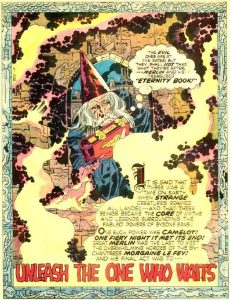
Kirbytech border
Next followed Kamandi; a dystopian tale of a future world where animals were in charge and humans were mindless beasts, except for one boy who had survived the great holocaust and finds himself adrift in a world that he doesn’t understand or control. If this seems reminiscent of Planet of The Apes, that’s because it was inspired by the movie. When DC couldn’t get the rights Carmine decided to make their own version. But this isn’t a simple remake of the movie. Kirby had done something similar many years before in a fantasy comic from Harvey, and his stories share more thematically with that short story than they do from the movie. The name Kamandi was also borrowed from a long lost newspaper strip Kirby had proposed in the 1950’s. Jack retrofitted the name and made the research facility that Kamandi lived in Command D. The physical appearance seems to be a continuation of the long flowing blond hair, devil may care adventurer template as earlier seen in Angel of Boy’s Ranch and Thor. We would see it again in Captain Victory. The child took the name of the facility as his own. Kirby took the kernel and produced a different and more wondrous world than Pierre Boulle ever considered. Kirby’s Kamandi was allegorical, topical, philosophical and just plain simple fun. This was what Infantino wanted and needed, the series would last for over four years and well after Kirby left the series. As per Jack’s history, he gave the child a mentor named Ben Boxer –who can transform his body into a nuclear reactor.
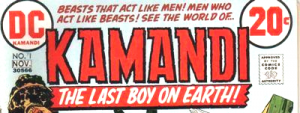
In late 1972 Jack had an idea. He approached DC to try to sell it. Jack had always loved C.C.Beck’s version of Captain Marvel. DC was now the owner of the property since the Fawcett lawsuit. Jack suggested bringing the character back and having Beck once again draw it. DC liked the idea, but turned it over to Editor Julius Schwartz to pursue. Beck would return to draw the strip but the results were less than satisfying. The DC writers could never match or understand Otto Binders self-parodying and innocent essence from the original strip. The book, titled Shazam,though widely anticipated soon floundered. Beck retired once again. Yet DC was able to sell a TV series featuring the intrepid family. After Beck left after issue #11, DC tried to force fit the series into the regular DC Universe to no avail. The series soon folded. Likewise Berni Wrightson introduced Swamp Thing in the back of a fantasy anthology book to great acclaim. The character soon received his own book as Berni provided beautiful artwork and the stories even included Batman, yet Berni soon left and the series was cancelled soon after.
Mike Kaluta made a wonderful attempt at reviving the old pulp character the Shadow-again to much acclaim, but little sales. DC was fighting for new successful series, yet was unable to find the right formula with old or new characters.
Marvel wasn’t doing much better. The downward spiral that started when Kirby stopped plotting hit freefall when Kirby left. Stan Lee had given up the day to day , and the editor position became one big musical chair. Jim Shooter said; “sales were bad and falling. It was almost all newsstand sales then, by the way. This was before the Direct Market was a significant factor. The comics overall were breakeven at best. Upstairs, the cheesy non-comics magazine department was losing millions. It seemed like the company as a whole was in a death spiral.” This, despite a few books like Conan, Master of Kung-Fu, and Tomb of Dracula selling very well.
Amazingly, on their bestselling book, Conan, Barry Smith—the low rate artist had become a super-star. Despite wanting only to work at Marvel, he had become disillusioned with their plantation mentality. In disgust, he left the comic industry to try out for fine art immortality. Suddenly in a book that they had wanted a low wage penciler was given their top rated artist, as John Buscema took over for a long run.
Smith would join several other disgruntled comic artists and create a fine art studio called “the Studio”. Along with Jeff Jones, Bernie Wrightson, and Mike Kaluta left comics to varying degrees to produce large prints and posters, and some book illustrations. Comics bad business design had lost some more talent at an already low point.
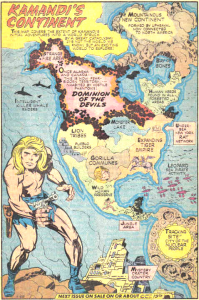
Jack created whole new worlds
Jack was known for his spontaneity, his willingness to react in an instant if a story came to him. In Kamandi it was no different. In 1974 the United States was living through a Constitutional crisis. In what has become known as the Watergate Affair, President Nixon was accused of participating in a cover up of a criminal break-in of the Watergate Hotel. In late 1973, we found out that Nixon had installed listening devices and recording capabilities in the Oval Office. When Congress learned that Nixon had recorded his conversations they subpoenaed the existing tapes, which led to a Supreme Court decision that forced Nixon to give up the tapes. When reviewed a mysterious segment of the tape was erased.
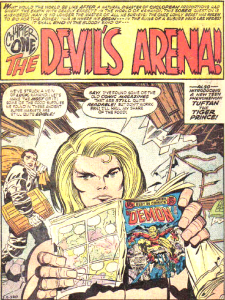
The boy showed good taste
While this was going on, Kirby came up with a Kamandi story about a group of apes who lived in the ruins of the Capitol in Wash. D.C. These apes were inspired by the words of the lost tapes that controlled their lives. The apes have formed a sect named the “bugs”. The hunters were called “plumbers” in honor of the mythical Nixon leak stoppers who broke into the Hotel. The sect’s society was built around mysterious spirit voices from the past heard thru the Watergate Sound-maker- a sonic device that can communicate, and destroy thru its amplified noise. After a tough battle, Kamandi and the Tigers are successful in beating back the apes and after dismantling the machine find that the source material was the lost Watergate tapes. When they attempt to play a tape they hear a short message and then a break. The message was “I want to make this perfectly clear”. This strange story appeared in Kamandi #15, dated March 1974. Seven months later Richard Nixon would resign the Presidency. One wonders if Jack received any blow back from such a political spoof during the height of the Country’s crisis. DC was a conservative operation and may not have liked such a partisan political statement.
Jack wasn’t one to usually let his politics intrude in his stories, but Richard Nixon brought out the worst in Kirby. Kirby had a political side. Jack’s son Neal reminisced in an interview for TJKC.


Pre-Kamandi Kamandi – God he hated Richard Nixon
TJKC: Would you consider him socially conscious?
NK: Oh absolutely. One thing I remember when Cesar Chavez was leading the grape boycotts in California. My mother came home with some grapes in a shopping bag, and he goes, “You can’t have those.” and he picks them up and throws them out the kitchen window. I remember we went to a cousin’s Bar Mitzvah. It was a simple affair, they had a meal set up. There was an old homeless man standing near the door looking in. My father took the guy by the arm brought him inside, sat him down at the table, and made him a plate of food. (ST note: Just as the Torah commands: When we see a guest, we should see an opportunity–an opportunity to teach, embrace, and learn. It is only through welcoming the stranger that we can truly fulfill our mandate as the children of Israel who left the desert and dwelt in Sukkot.)
After the first 15 episodes, Kamandi started the irrevocable tumble into sameness, schmaltz, and childish silliness with only the occasional burst of Kirby greatness coming through. Jack’s art stayed strong but slipped into a little parody of Kirby grandeur when Jack seemed to be trying too hard for the amazing. The stories suffered from over relying on the graphic end rather than the literary merit. Too often the scenes are too big—they lost the smaller plot cohesiveness needed for a good story.
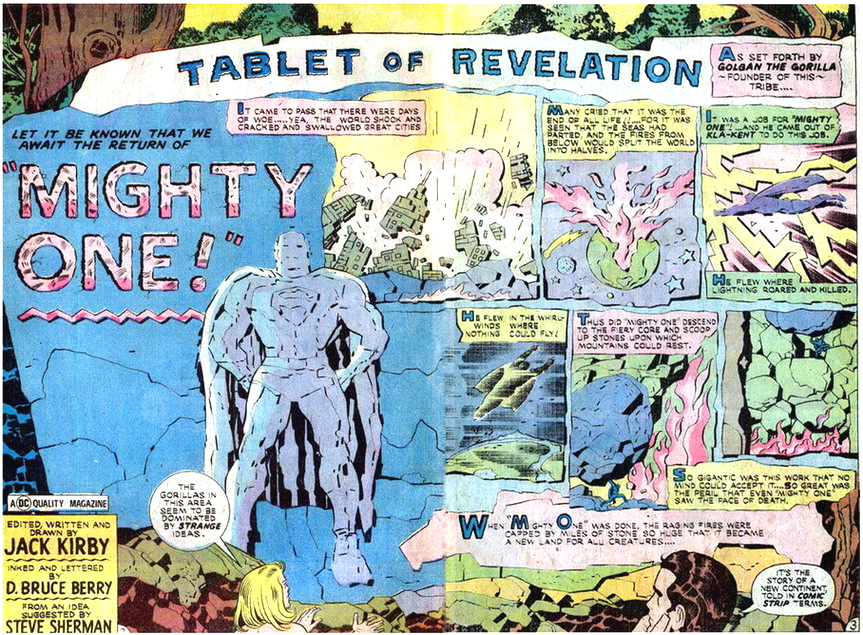
Days of future past – DC did exist
Kirby was given an ongoing war series called The Losers in a struggling DC war book Our Fighting Forces, and provided 12 issues. Kirby took this lemon and made some of the sweetest lemonade ever seen in funny books. These were some of the most personal stories Kirby had ever written; torn from his war time hell and the pages seemed to be written in blood. The Losers were a collection of DC’s small impact World War 2 heroes, whose own series had been cancelled. The series was very odd. There’s a pretty unhealthy dose of self-loathing within the Losers when you think about it; it seemed like every issue’s cover featured one or all of the Losers in very dire straits, with one of them yelling “Just another reason we were BORN to LOSE!” or something to that effect. However, none of that self-hatred is on display in the Kirby LOSERS stories I have here. Indeed, at a Kirby Panel in San Diego, Mark Evanier commented on how the very title of the feature must have rubbed Jack Kirby the wrong way, as “he would never think of a U.S. serviceman as a loser.” Kirby himself had been drafted in the fall of 1943 and served in the Third Army combat infantry. The series seemed to be rudderless until Kirby took it over. The hard core war themes are so different from the irreverent nature of the earlier Sgt. Fury books. The dangers are so magnified and the horror more pronounced. Yet Jack still found a way to make them enjoyable reads. One of the characters was Captain Storm, a P.T. boat skipper who had lost his boat and his leg in an attack. Storm got around with a wooden leg, and Jack could never figure out which leg was real and which was wood. One panel it would be the left and the very next panel it might be the right. Kirby’s penchant for details was never worse, but it didn’t matter.
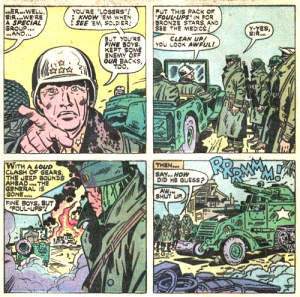
The Losers meet Patton
The real question is what was a gimpy P T Boat skipper doing marching around in an infantry brigade? Many consider this short series as the best work Kirby ever did in mainstream comics. In #152, Kirby tells a tale of tired soldiers coming upon a shelled out town and trying to secure it. It ends when the squad runs into Gen. George Patton himself and receives a dressing down. It’s not your usual everybody’s happy at the end tome.
It is of course relevant to remember that the real soldier Jack Kirby did have a run in with Gen. Patton and it too was not pleasant.


Kirby’s war wasn’t pretty
Just as this occurred, many of the young artists joined a new group; the Academy of Comic Book Arts. This quickly served as a vehicle for the artists listing their grievances. The new group was led by firebrand Neal Adams, and Archie Goodwin. Their demands had found no immediate ear among the companies.
After Martin Goodman sold Marvel, it was with the intention to keep his son Chip working at Marvel. Soon, Marvel summarily let Chip go in order to expand Stan Lee’s authority. So Martin financed a new venture for Chip that he named Atlas Comics. He hired indy vet Jeff Rovin as editor. He raided and filled his bullpen with ex-Marvel people like Larry Lieber, Steve Ditko, Wally Wood, and Neal Adams. Filled with great hopes and praising press coverage they started out with a bang—copying every genre and character that Marvel sold. Their aim was gutsy-take on No.1 straight up.
How Atlas decided to do this was revolutionary; they overthrew the whole dynamic of how comics were done. They offered the artists, complete return of original art; copyright ownership for the characters, and a higher page rate. This guaranteed that the hot artists and writers would flock to the new company.
Despite these crumbs, there were problems. The young writers did not bring great innovations, they brought carnage. These Marvel clones outdid the competition in only one way—body count, and nothing Martin demanded could stem the blood flow. Martin’s demands to match up with Marvel were too much. Lieber and Rovin explained that Marvel’s growth was organic over a long period of time and couldn’t be duplicated in just a year or so. Martin’s continuous demands finally led to Jeff Rovin leaving as it was left to Larry Lieber to run the business—but Martin had lost too much money and there was no way to recoup. Sadly, while Lieber was on jury duty he received a call to see Chip Goodman. He knew what was coming. Martin decided against throwing good money after bad.
Atlas Comics made no lasting mark on comics; they produced nothing of consequence, but their impact was unimaginable on the industry itself. As Jeff Rovin said when asked of any significance; “One was an ownership/profit sharing contract for artists and writers on any character(s) they created, and the other was the return of all artwork. Neither of these were being practiced at the time, and Martin grudgingly agreed to do so when he realized that that kind of arrangement, coupled with high page rates was a means of getting talent to work for us.” No one knew just what was set in motion would one day overwhelm the working relationships on the industry as a whole.
Jack Kirby was under contract to DC and never even considered heading to Atlas. When his contract ran out, Atlas was already floundering. It’s a fun what-if for Kirby to finally reap some of the rewards he had fought so strongly for.

They even stole the logo blurbs
Unfortunately at DC, Kirby threw concept after concept against the wall and nothing else stuck. OMAC, a wonderfully cynical idea, failed despite a plethora of sci-fi concepts and dazzling art. Manhunter (a continuation of the early S&K concept), Atlas, the kid group Dingbats of Danger Street all failed when offered in First Issue Specials—a test market book.


OMAC: Kirby at his most cubistic – A throwback concept a poor man’s Conan
An oddity came about when Joe Simon approached Carmine Infantino with a proposal to update the old S&K Sandman series. Carmine liked the idea but had an even better one. Why not have Joe write it and Jack Kirby draw it, just like in the old days.
Jack wasn’t entirely thrilled with the idea but agreed. The result was perhaps the most hyped book in DC’s history; the return of Simon and Kirby. The book was no great shake, Joe had lost his mojo a while back and this story didn’t recapture any of the zaniness one might expect. Kirby’s artwork was Kirby’s modern artwork, with no attempt made to recapture the wartime S&K fluidity and zaniness. Didn’t matter a whole lot, the book was a smash. Joe says it was DC’s best seller of the year. The series was given the go ahead for more issues, without Jack, though he did do the covers. He did return to draw the books with issue #4, but the series written by a DC hack regular was lackluster to say the least. Don’t know if it helped, but the cover of No.4 spotlighted Jack’s name as doing interior work.


Sandman #4 Jack returns Justice Inc. #2 – Even on hack books, Jack never hacked it—interesting take on stereotype
Kirby filled in a few other titles as he was working out the last couple months of his contract which called for a certain number of pages; but there was no there there. Kirby’s mind was once again thinking about starting fresh at a new/old home. He had run into Roy Thomas and when the subject turned to his time at DC, Kirby informed him that his contract was running out and he was available if Marvel would have him back.
Jack’s time at DC was short, and it’s hard to categorize. It wasn’t a failure; Jack produced some of the best work of his career, and enjoyed his modicum of freedom, and was paid his best rate ever while never missing a day. It was personal, powerful, intriguing, and cumbersome. It resonates just as strongly today. The characters have been revived time and time again and are now vital parts of the DC canon.


Simon and Kirby together– once more names on the cover – inks by Royer
Darkseid has become one of the great arch villains at DC, alongside the Joker and Lex Luther. But it also wasn’t a success; Jack would always tell anyone who would listen that his job was to make sales for the company. That’s how he judged his work and on that basis, his work never found the deep audience it deserved. I think it galled him that his most personal work wasn’t accepted. He knew they would eventually find an audience. There are many theories as to why; some claim behind the scenes machinations by editors, some blame lying sales reports, some blame DC’s business decisions and some blame Marvel’s business decisions, they may all be part right and we’ll never know the whole story, but taken for what it was, the comic world was better off for his time there.
Just as Jack was leaving, he received another commission from Pro! Magazine. This time they wanted a couple of illustrations to adorn an article on legendary quarterback, Fran Tarkenton.
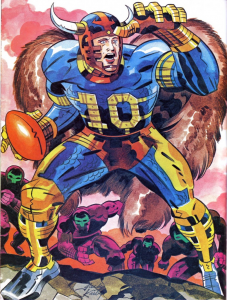
Why is the quarterback wearing Heimdall’s cape?
Previous – 20. Bullpen? Bullshit!! | Top | Next – 22. Allegory Of His Life


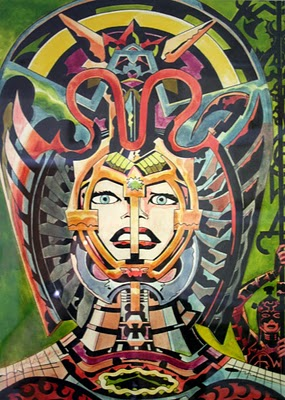
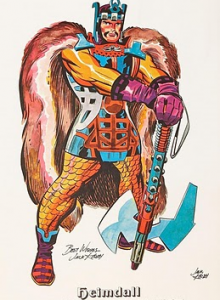
This is absolutely outstanding. Very disappointed that Stan Taylor is gone, however – I would love to read more from him.